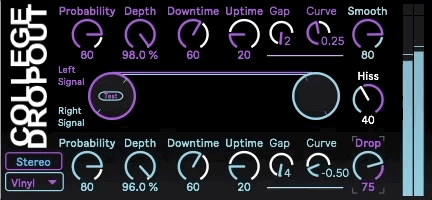PROGRAMS
I've played in the shallow end with some amateur JavaScript junk, and I’ve retained a little familiarity of my time tinkering with Xcode, but my jam of the past couple years is Max/MSP. Functionally, it’s much more gratifying to spin up some tools to that can create weird, stochastic sounds from nothing. I initially learned Max/MSP as an approach for easy DSP interaction and FFT processing, and branched out into simple applications of GenExpr, JavaScript, and C-sound as curiosity or necessity demanded.
I’ve taken some of my Max/MSP ideas and adapted them as patches to share for free with Ableton users on the maxforlive site. I’ve garnered 6,000 downloads so far (s’up ladies), and I’ve gotten some cool feedback on them.
Keeping in line with the native UI of Ableton that is accessible in the API, I’ve tried to straddle the line between a functional interface with minimum latency and low CPU usage, which sometimes requires small sacrifices for code optimization, but I’m proud of a lot of the solutions I’ve come up. I’ve collected a few of my favs here.
College Dropout and High School Crush are a pair of effects conceived to emulate old recording imperfections.
College Dropout is an audio-drop/pitch-drop effect akin to a battered old cassette tape that's due to pop any day now. I came up with a probabilistic algorithm to periodically drop the volume and, optionally, the pitch either in unison or stereo. I also tacked on some tape hiss and some other parameters (including some secret ~hidden~ controls) for the distinguished knob-tweaker.
High School Crush is a bitcrush/sample rate reduction effect. Typically, digital effects like this tend to cause harmonic resonances due to anti-aliasing, but I used three parallel instances to blur the harmonic relationship and added crossover filters with wet/dry controls to help shave off unwanted high frequencies to maintain the strength of the fundamental frequencies. Obviously, it's just what all the kids were clamoring for.


Grain Mill is a granular delay that uses two asynchronous granulator objects for that delicious fragmenting of realtime audio input à la Christian Fennesz and Tim Hecker. The audio channels can be mixed against the dry signal, and the master output can be further contoured by the additional side-chain compressor.at the end of the signal. For the connoisseur of the unusual, this is a multi-course meal of strange.

Most Simplest is an overhaul of the More Simpler counterpoint to Ableton's Sampler and Simpler. (Yeah, I know.) The purpose for this was to find a method to make a more adaptive sampler for foley recordings with a stronger utility set for handling pitch and artifacts. So, contrary to the simplified naming scheme, it features an array of switchable filters for each midi input (low-pass, high-pass, band-pass, and a series of peak-notch filters at various functional intervals) that can transition to a second filter array over a designated period of time. Sure, it's almost overbearingly niche, but musicians with advanced sound design demands will find that having access to a sampler with tight, polyphonic filters tied to individual inputs can save a tremendous amount of work in the final mixing stage.
